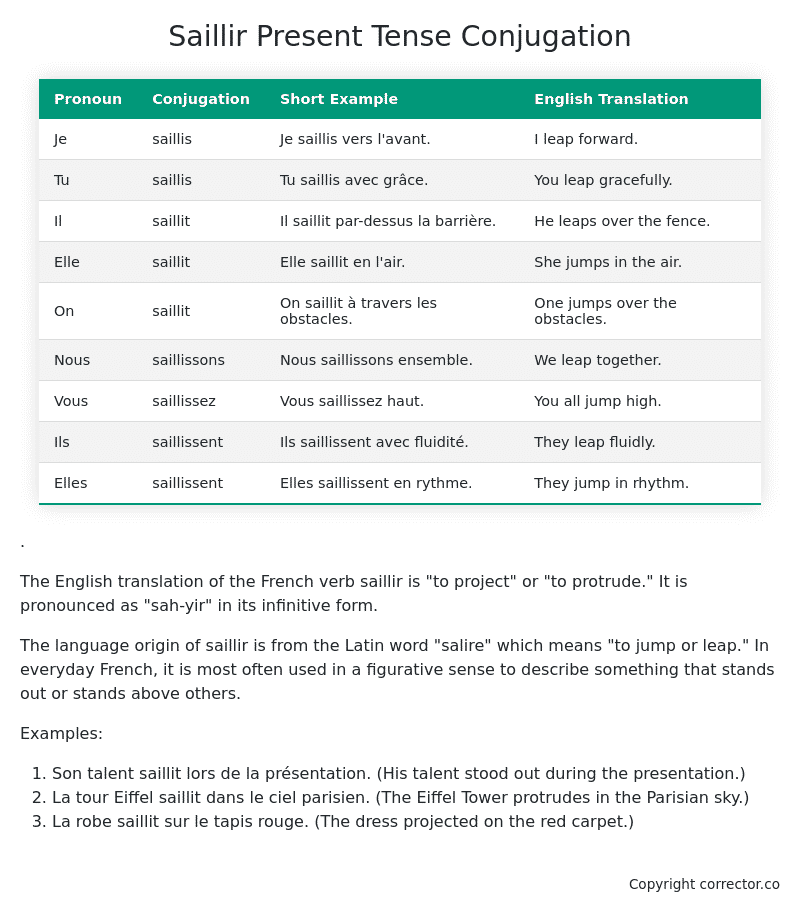Le Present (Present Tense) Conjugation of the French Verb saillir
Introduction to the verb saillir
.
The English translation of the French verb saillir is “to project” or “to protrude.” It is pronounced as “sah-yir” in its infinitive form.
The language origin of saillir is from the Latin word “salire” which means “to jump or leap.” In everyday French, it is most often used in a figurative sense to describe something that stands out or stands above others.
Examples:
- Son talent saillit lors de la présentation. (His talent stood out during the presentation.)
- La tour Eiffel saillit dans le ciel parisien. (The Eiffel Tower protrudes in the Parisian sky.)
- La robe saillit sur le tapis rouge. (The dress projected on the red carpet.)
Saillir – About the French Present Tense
To take a deep dive into all the French tenses then see our article on Mastering French Tense Conjugation.
Common Everyday Usage Patterns For Le Present
Interactions with Other Tenses
Table of the Present Tense Conjugation of saillir
| Pronoun | Conjugation | Short Example | English Translation |
|---|---|---|---|
| Je | saillis | Je saillis vers l’avant. | I leap forward. |
| Tu | saillis | Tu saillis avec grâce. | You leap gracefully. |
| Il | saillit | Il saillit par-dessus la barrière. | He leaps over the fence. |
| Elle | saillit | Elle saillit en l’air. | She jumps in the air. |
| On | saillit | On saillit à travers les obstacles. | One jumps over the obstacles. |
| Nous | saillissons | Nous saillissons ensemble. | We leap together. |
| Vous | saillissez | Vous saillissez haut. | You all jump high. |
| Ils | saillissent | Ils saillissent avec fluidité. | They leap fluidly. |
| Elles | saillissent | Elles saillissent en rythme. | They jump in rhythm. |
Other Conjugations for Saillir.
Le Present (Present Tense) Conjugation of the French Verb saillir (this article)
Imparfait (Imperfect) Tense Conjugation of the French Verb saillir
Passé Simple (Simple Past) Tense Conjugation of the French Verb saillir
Passé Composé (Present Perfect) Tense Conjugation of the French Verb saillir
Futur Simple (Simple Future) Tense Conjugation of the French Verb saillir
Futur Proche (Near Future) Tense Conjugation of the French Verb saillir
Plus-que-parfait (Pluperfect) Tense Conjugation of the French Verb saillir
Passé Antérieur (Past Anterior) Tense Conjugation of the French Verb saillir
Futur Antérieur (Future Anterior) Tense Conjugation of the French Verb saillir
Subjonctif Présent (Subjunctive Present) Tense Conjugation of the French Verb saillir
Subjonctif Passé (Subjunctive Past) Tense Conjugation of the French Verb saillir
Subjonctif Imparfait (Subjunctive Imperfect) Tense Conjugation of the French Verb saillir
Subjonctif Plus-que-parfait (Subjunctive Pluperfect) Tense Conjugation of the French Verb saillir
Conditionnel Présent (Conditional Present) Tense Conjugation of the French Verb saillir
Conditionnel Passé (Conditional Past) Tense Conjugation of the French Verb saillir
L’impératif Présent (Imperative Present) Tense Conjugation of the French Verb saillir
L’infinitif Présent (Infinitive Present) Tense Conjugation of the French Verb saillir
Struggling with French verbs or the language in general? Why not use our free French Grammar Checker – no registration required!
Get a FREE Download Study Sheet of this Conjugation 🔥
Simply right click the image below, click “save image” and get your free reference for the saillir Present Tense tense conjugation!

I hope you enjoyed this article on the verb saillir. Still in a learning mood? Check out another TOTALLY random French verb present conjugation!

